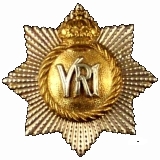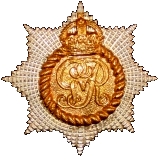
Recollections of a Nonagenarian
of Service in The Royal Canadian Regiment (1916-19)
Part 1
by Robert England, M.C.
1916; AND 1917 BEFORE VIMY.
Published privately in 1983 in the centennial year of The Royal Canadian Regiment (1883-1983).
Footnotes to Fetherstonhaugh (R.C.) The Royal Canadian Regiment 1883-1933. (1)
Despite the amazing variety of recruits of so many ethnic groups, Germans from Lunenburg (Nova Scotia), Slavs, French, Italians, from all of North America, McDonald was the only spy who tried this daring role in the R.C.R.,…
Four students of Canadian universities, aged between 19 and 22, subalterns of The Royal Canadian Regiment, Canadian Expeditionary Force battalion, in World War I, led "C" Company over the top alongside "D" Company in the attack on Vimy Ridge, at 5:30 a.m. on April 9, 1917, as part of the four Division Canadian Corps, commanded by Sir Julian Byng. (2) It was the opening of the French and British armies, under Generals Neville and Haig, planned grand offensive on the Western Front on the strong fortress position, linch pin of the whole line, held by the German Army in France since 1914. The students were T. Stephens Allan (McGill), F.I. Lewis (Toronto), Robert England (Queen's) and W.M. Wallar (Manitoba).
Wallar received his commission after service in France with the P.P.C.L.I. Allan, Lewis, and I were commissioned in Canada, underwent special training in Shorncliffe (Eng.) and had been drafted to the R.C.R. early in October 1916. At Shorncliffe, barrack square close order drill was directed by Capt. J.S. Legge, a former R.C.R. Sgt. Major. One day our parade was suddenly interrupted by General Sir Sam Hughes, the Canadian Minister of Defence, surrounded by red-tabbed staff. He challenged our squad to take over from the instructor, indicating Steve Allan, who took up position beside the Minister. "Don't be nervous," urged Sir Sam, to which Steve Allan rejoined, "I'm not nervous, Sir." We performed our squad drill evolutions to the Minister's satisfaction, who then admonished the Commandant, Capt. Legge and our instructor "These young fellows don't want to spend time on squad drill, they want musketry, revolver and weapon training and then get on to France." Within days we were on our way to join the R.C.R. which, during the past two months (due to the Somme casualties mainly) had lost 21 officers and approximately 650 other ranks (Fetherrstonhaugh, p. 259). When at Tara Hill and Warloy in the Somme area the senior permanent force officers were Lt. Col. C.H. Hill (serving since 1901), Major C.R.E. Willets (since 1906), Capt A.E. Willoughby (since 1910), Capt. Hans Logan (since 1913).
During the winter of 1916-17 reinforcements from the 17th Reserve at Bramshott, many from Nova Scotia, and from a battalion recruited from the United States gave the R.C.R. a great variety of men, some with wide experience of armed service, guerrillas from Mexico, cowboys and hobos from the Western States.
Lt. Col. Hill was something of a martinet, a great believer in the merits of close-order drill, discipline, smart deportment, physical training to redeem careless characters and establish recruits as alert, steady Royal Canadians. Junior officers did not escape: a half-day-of-rest on the march found us on the square under Sgt. Major Roberts and the Colonel acquiring the special detail used by the R.C.R. in ceremonial, "Fix Bayonets" routine, and most important-saluting. The regimental tailor, the most devoted patient permanent force specialist I have ever known or could imagine, with the unusual name of Snook was the superb dresser behind the stage of the dress, pipe-clay Band equipment, and the Hawkes Savile Row tailoring of the officers. The colonel and his officers worked hard to maintain their peace-time smart appearance on parade, traditions and mess etiquette and NCO's p.t. competence and assurance compelled the new junior officers to fall in line. It was easy to do so with Capt. Mike Ryan, the bandmaster lovable and hospitable to us, he and his band were probably the best in the Canadian Corps just as adept in concerts in dispensing "William Tell," "Poet and Peasant," snatches of Strauss, Offenbach and Verdi as "Colonel Bogey," "Oh you great big beautiful doll" and the regimental march past.
We were young, met our conditioning by the Regiment, with cheerfulness, expected no favours, but we were far from subaltern in attitudes given our background. By the spring of 1917 we had been seasoned by trench warfare, raids, tours of duty, and weapon training, and we knew the importance of a stable pattern of command, confidence in the discipline and morale of the men and in the artillery and machine-gun fire-power and in the firm logistical supply of ammunition and rations. We had had time to learn about Vimy Ridge.
The German Army had made its defence system seem impregnable to them. The Ridge was about six miles long, seen from the southwest slopes, rising gradually in an escarpment, which, on its eastern side falls suddenly from its highest point 250 feet to the flat plain of Douai and to the roads to Arras. The Germans had thus easy screened access for troop and supply movements directly and laterally and they had honey-combed the Ridge with tunnels, dug-outs, and various types of underground passages with dry quarters for troops.
In contrast, the Canadian sector of trenches and communications were under perfect enemy observation, and water-logged by downhill drainage, heavy rains, frosts and thaws and the continuous churning up of shelling, mine explosions, and trench mortar attacks. The mire in the forward lines with parapets and sides sliding into a thick soup of occasional swollen dead bodies, rats, rotting sandbags, shrapnel and shell fragments, rusting metal and tins, broken bathmats and all the detritus of lost battles was the burial ground of 200,000 British, French and Germans.
Despite the contrasting conditions, General von Bacmeister, 79th Reserve Division of German Army, reported on March 30, 1917: (3)
North of Arras the British will be forced, according to the nature of the ground, to deliver a joint attack on the long narrow Vimy Ridge, the possession of which would give them command of the high ground in this vicinity. They would also be a safeguard against German attacks on the left British flank near Arras. Opposite this division Canadians were placed. The Canadians are known to be good troops, and are therefore well-suited for assaulting. There are no deserters to be found among the Canadians. It is very certain that the Canadians are planning an attack on a large scale in the immediate future. The statement of a prisoner captured early today that the attack was to take place between March 20th and April 6th confirms the above.
German intelligence could on occasion be deadly effective. In the winter of 1916-17 the R.C.R. had an excellent stretcher-bearer called McDonald. On leaving for Bruay about February 12, 1917, we reported McDonald missing. But in the summer of 1917 McDonald surfaced with letters posted in neutral countries, urging some of our men, whom he had known, to desert and stop the war. Counter-intelligence was on his trail and I gathered from enquiries being made by Brigade Intelligence through me, as Scout Officer, that his letters indicated his spy activities in British armies could not be resumed. But undoubtedly the German army had been alerted to a probably Canadian attack.
Despite the amazing variety of recruits of so many ethnic groups, Germans from Lunenburg (Nova Scotia), Slavs, French, Italians, from all of North America, McDonald was the only spy who tried this daring role in the R.C.R., and he certainly quietly merged into the pattern—neat, efficient and willing to help, without deliberately obviously bearing arms. Had he been untidy in the R.C.R. he would have been marked. I had a former bank clerk in my platoon who could never seem to dress properly, and Sgt. O'Connor tried to foist him off on requisitions from orderly room for carpenters, etc., but without success. One night he lost gum-boots and trousers in a front-line trench in the sticky mire and they couldn't be found. Sgt. O'Connor detailed two men to wash him down with precious water from the old petrol tins, then sewed two empty sandbags together for a pair of trousers, and sent him to the M.O. to get him out-of-the-life for re-equipment by quartermaster stores.
What a problem clothes and gum-boots and trench gear were! Our popular Lewis Gun officer was caught at morning latrine by the usual German straffing after breakfast, and he needed more than cold water, and trousers, and eau de cologne. We four, who had J. S. Woods, M.C. and bar, (Smokee) as our company commander were well instructed and trained in the emergencies and accidents of trench-life and warfare. He was about the most knowledgeable and innovative of all the officers, a good eye for terrain, and a quick reader of maps.
"Smokee" was loved by his men, and he insisted on our primary duty-ensuring the welfare of our platoons. By 1916 the higher command was endeavouring to push the concept of the platoon with its rifle grenade, bombing, riflemen and Lewis Gun sections as a tactical unit under a trained commander familiar with the area, the capabilities of manoeuvre, and appreciation of terrain and of map-reading.
All of the platoon commanders had had courses during the winter. Steve Allan spent two weeks with the Grenadier Guards, and while he was impressed by their discipline and competence, he was disturbed by the gap between the meagre comforts and rationing of the men and the high standard of the officers' mess and affluent style. I had a Lewis Gun course at Paris-Plage, and then a ten-day liaison stay with a 9.2 howitzer counter-battery unit, remembering sufficient trigonometry and map-reading to share in a "shoot," answer questions about our trench life and go with an officer to an "Observation Post" to watch the shelling and note the results. While there, General Massie came on an inspection and was so pleased with the liaison idea, he invited me to dinner at his headquarters. The group colonel took me in his car, and after dinner I was shown their maps with pins identifying enemy gun positions. General Massie asked if there was anything else I'd like to see and 1 expressed an interest in the sound-ranging project, then very new. Once again, the group colonel agreed to take me, and 1 had a useful visit to see the equipment mounted on a truck and managed by a young scientist, who explained his triangular microphone listening devices for the sound of the enemy gun and the measurement of the speed of sound at each point to secure a "fix." The aerial observation still remained the most important source of locating enemy guns.
But all was not work. Lt. Col. Hill gave me two odd assignments, and I never understood the rationale for his choice of me in either. I was sent to represent the R.C.R. at a gathering of officers to meet Arch-bishop Lang of York. On the other hand I was deputed to take the mess cart and proceed with a corporal and an O.R. to Bethune to purchase liquor supplies, especially scotch whiskey, for the delayed Xmas dinner in January 1917. The date was December 31, and the Army and Navy Canteens had only two bottles of whiskey left and 1 had to load up on gin and vermouth, some white wine and port. (I was later blamed for morning after headaches.) I had lunch in the Officers Club in Bethune, a place I knew as Steve Allan, Fred Lewis and I persuaded Capt. Phillips (Transport) to lend us horses which we rode to Bethune for dinner on a couple of occasions.
On New Year's Eve I was invited to the Christmas and New Year dinner of the P.P.C.L.I. (4) in Mont St. Eloi, and heard the messages that passed between Lt. Col. A.A. Adamson and Princess Patricia and Major H. Gault, a strong family spirit animated the whole Regiment.
- The O'Leary Collection; Medals of The Royal Canadian Regiment.
- Researching Canadian Soldiers of the First World War
- Researching The Royal Canadian Regiment
- The RCR in the First World War
- Badges of The RCR
- The Senior Subaltern
- The Minute Book (blog)
- Rogue Papers
- Tactical Primers
- The Regimental Library
- Battle Honours
- Perpetuation of the CEF
- A Miscellany
- Quotes
- The Frontenac Times
- Site Map

![]() The RCR in the Great War
The RCR in the Great War
![]() War Diary
War Diary
![]() Battle Honours
Battle Honours
![]() Battle Bars and The RCR
Battle Bars and The RCR
![]() The RCR Battle Bar Ledger (pdf)
The RCR Battle Bar Ledger (pdf)
![]() Honours and Awards
Honours and Awards
![]() Roll of Honour
Roll of Honour
![]() Prisoners of War
Prisoners of War
![]() Cemetery List
Cemetery List
![]() Cemetery Map
Cemetery Map
![]() Courts Martial
Courts Martial
![]() Officers
Officers
![]() RSMs of The RCR (1914-1919)
RSMs of The RCR (1914-1919)
![]() NCOs and Soldiers
NCOs and Soldiers
![]() An Officer's Diary (1914-1918)
An Officer's Diary (1914-1918)
![]() Recollections of a Nonagenerian (R. England) (1916-1919)
Recollections of a Nonagenerian (R. England) (1916-1919)
![]() On to Bermuda (1914-15)
On to Bermuda (1914-15)
![]() England and France 1915-1916 (Hayes; 1931)
England and France 1915-1916 (Hayes; 1931)
![]() Overseas with The Royals (1915)
Overseas with The Royals (1915)
![]() Regimental History Pamphlet (1917)
Regimental History Pamphlet (1917)
![]() Amiens (1918)
Amiens (1918)
![]() Cambrai (1918)
Cambrai (1918)
![]() Monchy-le-Preux (1918)
Monchy-le-Preux (1918)
![]() Under-aged Soldiers in The RCR
Under-aged Soldiers in The RCR
![]() Not All Were Volunteers; The RCR and the Military Service Act
Not All Were Volunteers; The RCR and the Military Service Act
![]() Sentenced to Death by Court Martial
Sentenced to Death by Court Martial
![]() The 7th Trench Mortar Battery
The 7th Trench Mortar Battery
![]() A Regimental Goat
A Regimental Goat
![]() Regiment and Family, Bermuda 1914-15
Regiment and Family, Bermuda 1914-15
![]() "March the Guilty Bastard In"
"March the Guilty Bastard In"
![]() Surrendered as Stowaway
Surrendered as Stowaway
![]() Re-Visiting the Great War Roll of Honour for The RCR
Re-Visiting the Great War Roll of Honour for The RCR
![]() Canadian Corps Trench Standing Orders (1916)
Canadian Corps Trench Standing Orders (1916)


